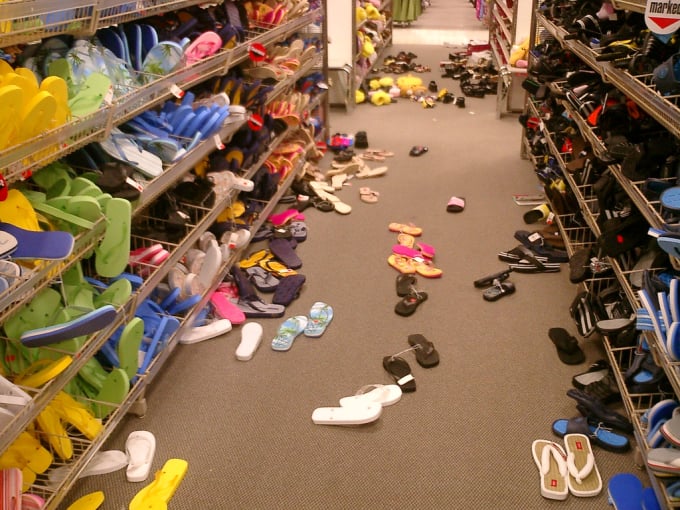
4 Ways Poor Customer Service Is Ruining Your Brand Identity
4 Ways Poor Customer Service Is Ruining Your Brand Identity
Your brand consists of more than your logo, color scheme, and brand standards: It also includes your business values, your company’s personality, and the way you treat your customers. Great customer service can help your company attract and retain a loyal customer base, but just one customer service slip-up can be enough to prevent customers from returning.
Here are four common customer service mistakes that can undermine and destroy your carefully crafted brand identity:
1. Uninviting marketing: Looks do matter, and your customers judge your business on appearance first. From the moment a customer approaches your retail store, your branding and overall appearance need to be crisp, clean, and inviting. Your storefront should be orderly and well-maintained.
I recently visited a grocery store with a burned-out sign that read “iant Food” — definitely not the message Giant Food meant to convey. Even if you’ve managed to get customers through your door, an unpleasant appearance — as small as a dirty bathroom — can cause them to disassociate themselves from your brand.
2. Poor customer communication: Many retailers think it’s enough to give the appearance of being welcoming, greeting customers at the door…and that’s it. They overlook the impact of a warm, sincere greeting and a genuine dialogue that makes the customer feel valued and appreciated.
One example of a retailer with the wrong communication approach is Best Buy. Instead of a greeter, visitors entering a Best Buy store encounter an employee whose job is to prevent theft by tracking customers’ every move on the store’s surveillance system. I believe that the company should worry less about the guy smuggling a GPS out under his shirt and focus more on the honest customer who visits the store and leaves empty-handed, dissatisfied, and confused. Good customer communication lets a consumer know that the company is on his side and willing to go the extra mile when needed.
3. Inconsistency: Your customers need to know that wherever they encounter your brand, they’ll receive the same level of positive customer service. Consider one of the most successful McFranchises ever: No matter where you are, a stop at McDonald’s offers fast service, uniform pricing, and consistent taste. However, the company has recently acknowledged that since its fast-paced introduction of several new products and limited-time offers, customer service has suffered. The variety of new products made operations more challenging at the chain’s restaurants, translating to slower service and increased consumer complaints.
McDonald’s recognizes the importance of consistently good service and plans to rectify the situation by focusing on better training for crew members, speeding up the assembly process, and addressing demand for customized orders. Having a uniform experience across your locations is absolutely essential for maintaining your brand.
4. Poor execution: I can list many best practices for policies, processes, and promotions to establish a great customer service experience, but even the best-laid plans will fail without good brand execution. J.C. Penney’s recent transformation is a glaring example of what can go wrong when a company fails to properly execute its new vision.
When J.C. Penney did away with sales and coupons and announced a revamped store with “fair and square” pricing, sales plummeted. New advertisements were aimed at a consumer drowning in a sea of too many coupons and promotions; the new J.C. Penney would offer a life vest — at an everyday low price! The company’s message was inconsistent with its own core values and long-standing model of offering discounts; more importantly, the sale-weary consumer doesn’t seem to exist.
J.C. Penney’s existing customer base of bargain hunters was confused by the sudden change and complained that the new pricing structure made good deals harder to find. J.C. Penney’s repositioning was a bold strategy, but it was implemented too quickly, without the necessary planning, positioning, and execution. The company slowly began reintroducing promotions and price drops, eventually returning to its original pricing structure.
Building a brand means influencing the gut reaction your customers have when they think about and interact with your company. Lowe’s is one brand that has consistently worked to craft a positive image as a company that cares about its customers. The company has been building its brand on better execution, from merchandising to an online order system that has customers’ items ready for pickup in 20 minutes. Lowe’s has embraced technology to improve customer communication, including an app providing store hours and locations, how-to videos, and quick access to its online catalog. Its customer loyalty has grown steadily as a result.
Your customers are your company’s lifeblood, and they want to feel valued and like they belong. By offering a pleasant, comfortable, and consistent retail experience and focusing on your customers’ needs, you can build and sustain a brand identity that will make them feel right at home.


